
Baltimore's rage is driven by rampant inequality
The scenes in Baltimore on Monday hark back to the riots of April 1968 sparked by the assassination of the black civil rights leader Martin Luther King.
In response Maryland's governor, Larry Hogan, declared a state of emergency and deployed 4,000 members of the National Guard to patrol the city's streets. Many were in Humvees and armored personnel carriers.
Riot police, armed with automatic weapons and batons, stood shoulder to shoulder to form impenetrable walls against demonstrators, all the while beating their shields as Roman legionnaires did 2,000 years ago.
On Tuesday, Hogan promised: "We're not going to have another repeat of what happened last night. We're going to make sure we get Baltimore back on track."
Baltimore's mayor, Stephanie Rawlings-Blake, ordered a city-wide curfew from 10pm to 5am for a week, unless there was a medical emergency.
She ordered all schools closed until Wednesday. The city's famous Orioles baseball team was forced to cancel one game and for the first time hold another in front of an empty stadium.
In the post-riot daylight, the city resembled a war-zone under military occupation.
It was a draconian response to a night of mayhem, which came after a week of largely peaceful demonstrations in West Baltimore over the death of Freddie Gray, a black man who suffered fatal injuries in custody.
| Reports have emerged that implicate police in at least not providing him with the critical care that he needed. |
The police claim that Gray was arrested on 12 April on a "weapons charge in a high-crime area of Baltimore known for drugs". He fled an initial approach, giving police reason to suspect, but then "gave up without the use of force", said Baltimore's deputy commissioner, Jerry Rodriguez.
An officer took his Taser electric-shock gun out but never used it during the arrest, Rodriguez said. And none of the six officers involved describe using force against the 25-year-old.
Gray was placed inside a police van and was able to talk, said Rodriguez. A video of his arrest shows him walking. But within half an hour, Gray was in an ambulance suffering severe spinal injuries, and died on 19 April.
Reports have emerged that implicate the police in at least not providing him with the critical care that he needed.
Dozens of the angry teenagers, just home from schools after Gray's funeral on Monday, responded with a rampage and looting frenzy, giving Hogan his reason to deploy the National Guard.
Barack Obama, on Tuesday called the Baltimore riots a "slow-rolling crisis" of riots in reponse to the death of black men at the hands of US police, that demanded a period of national soul-searching.
The president also said that the problem went far beyond the police, who he said were too often deployed to "do the dirty work" in dilapidated urban communities where fathers are absent, drugs dominate and education, jobs and opportunities are nonexistent.
"It's too easy to ignore those problems or to treat them just as a law-and-order issue, as opposed to a broader social issue," he said.
In many ways, Baltimore tells a tale of two cities; separate and unequal. According to Dan Diamond, a lifelong resident and a writer for Slate: "For decades, Baltimore has struggled to solve persistent inequality that puts people down - and keeps them down."
He grew up in "charm city" - the area stretching along tree-lined streets near Johns Hopkins University, the art museum and private schools where the mainly white population dreams and achieves.
Freddie Gray died in the other side of the city where despair, disrepair, crime and drugs - where poor black teenagers never have the chance to dream, let alone achieve; where life expectancy is at least 20 years less than in "charm city", according to a Johns Hopkins study.
| Almost a quarter of Baltimore residents live in poverty. The unemployment rate in West Baltimore was 19.1 percent in 2011. |
Almost a quarter of Baltimore residents live in poverty. The unemployment rate in West Baltimore was 19.1 percent in 2011. Less than 60 percent of Baltimore's children finish school.
Taken together, Diamond says, "these disparities illustrate what poverty's like in big-city America. And the effects are brutally obvious in Baltimore's healthcare figures.
"Black infants in Baltimore are almost nine times more likely to die before age 1 than white infants. Aids cases are nearly five times more common in the African-American community."
Such figures of inequality between white and black areas are not unique to Baltimore. More than 35 percent of Cleveland residents live in poverty. More than 39 percent of people in Detroit do.
In Washington, the "capital of the free world", the unemployment rate is 16.5 percent in black part of the city, compared to 5.4 percent in the white areas. The story is the same across all large cities in the US.
It is only a matter of time before things erupt over and over again, as long broken communities, schools, bad jobs and scarce opportunities are the norm.
As Baltimore burns, it is sensible to remember that inequality is at the heart of the matter.




